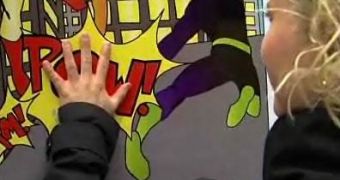Digital paper, also known as interactive paper, is patterned paper used in conjunction with a digital pen to create handwritten digital documents. The printed dot pattern uniquely identifies the position coordinates on the paper. The digital pen uses this pattern to store the handwriting and upload it to a computer. It should not be confused with electronic paper.
A team of scientists in Sweden claims that this paper can transform boring billboards and complicated static maps into interactive displays with the help of conductive inks that can print touch sensors and speakers on the surface.
"The first generation of paper was for display, like books," says Mikael Gulliksson, a researcher at Mid Sweden University, Sundsvall, Sweden, "the second for packaging, and the third for hygiene - we are investigating what the fourth might be."
The scientists named the material "paper four" and created an interactive billboard 2 meters high at the university, to prove it's possible. The most interesting thing is the fact that the billboard responds to the touch of the users by playing clips from music albums or spoken dialog from a comedian.
"We've used the roll-to-roll methods used by industry to process paper materials," said Gulliksson. Constructed almost entirely out of paper, the billboard is cheap to assemble and easily recyclable.
Conductive inks that contain silver particles were used to make the surfaces interactive and they do that by overlapping and allowing an electric current to flow through them. When electricity runs through a sheet of paper screen-printed with conductive ink and a second sheet carrying the billboard's design placed on top, simple microelectronics play, pause and rewind sounds.
When a hand touches the sensors made of a fine pattern of conductive lines, the paper realigns the ink to display another image, or makes electromagnets vibrate in response, creating a sound.
"The result looks and feels like paper but has electronic, interactive features," says Gulliksson. Future applications could use electronics integrated onto the paper surface by printing on semiconducting polymers.

 14 DAY TRIAL //
14 DAY TRIAL //